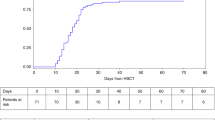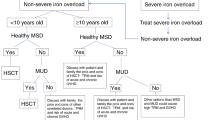Abstract
Fanconi anemia (FA) is a rare autosomal recessive disease characterized by congenital abnormalities, cancer predisposition and progressive BM failure. FA patients present spontaneous and induced chromosome breakage. Hematopoietic SCT (HSCT) represents the unique therapeutic option to restore normal hematopoiesis when marrow failure or clonal hematopoietic abnormality occurs. Conventional myeloablative conditioning regimen, especially including a high dose of irradiation, appeared strongly toxic for FA patients. Then, reduced-intensity conditioning regimens were developed successfully for those patients. However, TRM still remained higher than for other HSCT indications. The development of fludarabine containing a non-myeloablative conditioning regimen appears to be a major progress. Long-term follow-up is absolutely necessary.
This is a preview of subscription content, access via your institution
Access options
Subscribe to this journal
Receive 12 print issues and online access
$259.00 per year
only $21.58 per issue
Buy this article
- Purchase on Springer Link
- Instant access to full article PDF
Prices may be subject to local taxes which are calculated during checkout
Similar content being viewed by others
References
D’Andrea AD, Dahl N, Guinan EC, Shimamura A . Marrow failure. Hematology 2002; 58–72.
Bagby GC, Alter BP . Fanconi anemia. Semin Hematol 2006; 43: 147–156.
Mace G, Briot D, Guervilly JH, Rosselli F . Fanconi anemia: cellular and molecular features. Pathol Biol (Paris) 2007; 55: 19–28.
Soulier J, Leblanc T, Larghero J, Dastot H, Shimamura A, Guardiola P et al. Detection of somatic mosaicism and classification of Fanconi anemia patients by analysis of the FA/BRCA pathway. Blood 2005; 105: 1329–1336.
van Zeeburg HJ, Snijders PJ, Pals G, Hermsen MA, Rooimans MA, Bagby G et al. Generation and molecular characterization of head and neck squamous cell lines of fanconi anemia patients. Cancer Res 2005; 65: 1271–1276.
Alter BP, Greene MH, Velazquez I, Rosenberg PS . Cancer in Fanconi anemia. Blood 2003; 101: 2072.
Rosenberg PS, Alter BP, Ebell W . Cancer risks in Fanconi anemia: findings from the German Fanconi Anemia Registry. Haematologica 2008; 93: 511–517.
Rosenberg PS, Greene MH, Alter BP . Cancer incidence in persons with Fanconi anemia. Blood 2003; 101: 822–826.
Berger R, Bernheim A, Gluckman E, Gisselbrecht C . In vitro effect of cyclophosphamide metabolites on chromosomes of Fanconi anaemia patients. Br J Haematol 1980; 45: 565–568.
Gluckman E, Devergie A, Dutreix J . Radiosensitivity in Fanconi anaemia: application to the conditioning regimen for bone marrow transplantation. Br J Haematol 1983; 54: 431–440.
Gluckman E, Devergie A, Schaison G, Bussel A, Berger R, Sohier J et al. Bone marrow transplantation in Fanconi anaemia. Br J Haematol 1980; 45: 557–564.
Socie G, Devergie A, Girinski T, Piel G, Ribaud P, Esperou H, Parquet N et al. Transplantation for Fanconi's anaemia: long-term follow-up of fifty patients transplanted from a sibling donor after low-dose cyclophosphamide and thoraco-abdominal irradiation for conditioning. Br J Haematol 1998; 103: 249–255.
Flowers ME, Zanis J, Pasquini R, Deeg HJ, Ribeiro R, Longton G et al. Marrow transplantation for Fanconi anaemia: conditioning with reduced doses of cyclophosphamide without radiation. Br J Haematol 1996; 92: 699–706.
Gluckman E, Wagner JE . Hematopoietic stem cell transplantation in childhood inherited bone marrow failure syndrome. Bone Marrow Transplant 2008; 41: 127–132.
Kapelushnik J, Or R, Slavin S, Nagler A . A fludarabine-based protocol for bone marrow transplantation in Fanconi's anemia. Bone Marrow Transplant 1997; 20: 1109–1110.
Wagner JE, Eapen M, MacMillan ML, Harris RE, Pasquini R, Boulad F et al. Unrelated donor bone marrow transplantation for the treatment of Fanconi anemia. Blood 2007; 109: 2256–2262.
Yabe M, Yabe H, Hamanoue S, Inoue H, Matsumoto M, Koike T et al. In vitro effect of fludarabine, cyclophosphamide, and cytosine arabinoside on chromosome breakage in Fanconi anemia patients: relevance to stem cell transplantation. Int J Hematol 2007; 85: 354–361.
Farzin A, Davies SM, Smith FO, Filipovich A, Hansen M, Auerbach AD et al. Matched sibling donor haematopoietic stem cell transplantation in Fanconi anaemia: an update of the Cincinnati Children's experience. Br J Haematol 2007; 136: 633–640.
Ayas M, Al-Jefri A, Al-Seraihi A, Al-Mahr M, Rifai S, Al-Ahmari A et al. Allogeneic stem cell transplantation in Fanconi anemia patients presenting with myelodysplasia and/or clonal abnormality: update on the Saudi experience. Bone Marrow Transplant 2008; 41: 261–265.
Bitan M, Or R, Shapira MY, Aker M, Resnick IB, Ackerstein A et al. Fludarabine-based reduced intensity conditioning for stem cell transplantation of Fanconi anemia patients from fully matched related and unrelated donors. Biol Blood Marrow Transplant 2006; 12: 712–718.
Locatelli F, Zecca M, Pession A, Morreale G, Longoni D, Di Bartolomeo P et al. The outcome of children with Fanconi anemia given hematopoietic stem cell transplantation and the influence of fludarabine in the conditioning regimen: a report from the Italian pediatric group. Haematologica 2007; 92: 1381–1388.
Gluckman E, Rocha V, Ionescu I, Bierings M, Harris RE, Wagner J et al. Results of unrelated cord blood transplant in fanconi anemia patients: risk factor analysis for engraftment and survival. Biol Blood Marrow Transplant 2007; 13: 1073–1082.
Author information
Authors and Affiliations
Corresponding author
Rights and permissions
About this article
Cite this article
Dalle, JH. HSCT for Fanconi anemia in children: factors that influence early and late results. Bone Marrow Transplant 42 (Suppl 2), S51–S53 (2008). https://doi.org/10.1038/bmt.2008.284
Published:
Issue Date:
DOI: https://doi.org/10.1038/bmt.2008.284
Keywords
This article is cited by
-
Non-genotoxic conditioning for hematopoietic stem cell transplantation using a hematopoietic-cell-specific internalizing immunotoxin
Nature Biotechnology (2016)
-
Excellent outcome of allogeneic bone marrow transplantation for Fanconi anemia using fludarabine-based reduced-intensity conditioning regimen
International Journal of Hematology (2012)



